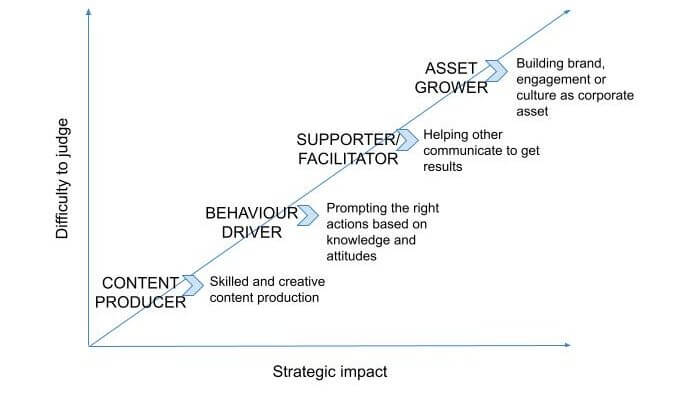This blogpost is part of the “Belonging is a mindset” blog series derived from my academic research on ‘internal communication and belonging in the virtual workplace’ for the Rotterdam School of Management, Erasmus University. The data from this study was collected from new hires who started their jobs in the middle of the pandemic and internal communication practitioners. This blogpost is part of my literature review.
This crisis brought about by the coronavirus pandemic provided internal communication the space to play a strategic role. That insight preceded the pandemic. Dewhurst and Fitzpatrick (2019) refer to internal communication as a behaviour driver and asset grower of an organisation, along with being a content producer and supporter/facilitator. In the below figure, they indicate the added value of internal communication.

Content producing refers to the basics of internal communication, which are creating content, storytelling, and managing employee communication channels. This requires imagination, creativity, understanding of communication models, and project management. Behaviour driving is connected with delivering outcomes, such as expected behaviours during change, or positive attitudes. Supporting/facilitating is about helping others to achieve their communication goals. Successful leadership communication or manager-employee communication falls under this category. Asset growing is about building intangible assets, from engagement to ambassadorship and positive culture, which in turn affect an organisation’s external reputation.
I posit that designing a sense of belongingness in the workplace is a product of the asset growing function of internal communication. This is in line with the internal corporate communication model presented by Welch and Jackson (2007).

Welch and Jackson suggest that internal corporate communication have four main goals which include:
- contributing to internal relationships characterised by employee commitment,
- promoting a positive sense of belonging in employees,
- developing employee awareness of environmental change, and
- developing employee understanding of the need for the organisation to evolve its aims in response to, or in anticipation of, environmental change (Welch and Jackson, 2007).
In the middle of this framework are managers who facilitate commitment, awareness, understanding, and belonging of employees.
They defined a sense of belonging as having a “we feeling” (Cornelissen 2004: 68) and suggested that internal communication can promote this in an organisation with the way it is organised. They added that when an organisation’s strategic managers prioritise “promoting commitment, awareness of its changing environment and understanding of the evolving aims” (Welch and Jackson 2007: 193) of the organisation that employees identify. This affects their sense of belonging and commitment to the organisation which in turn affects how much they respect and support their organisation.
Next up
What if the organisation at hand operates primarily in the virtual space? In the next blogpost, I will write about the challenges in the virtual workplace.
References
- You will find a full list of references here.


